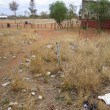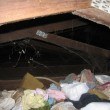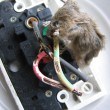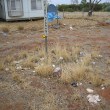A3.1 Fire prevention
Good housing design and maintenance can prevent fires. For example, when all lights in a house are working, which means that power is available and the light switches, fittings, and globes or tubes are working, there is less likelihood that candles will be used, reducing a major fire hazard. Similarly, if the stove and heater are working and safe outdoor cooking places are provided, there is less chance of people making fires around the perimeter of the house.
Poor electrical works can also cause fires, so careful design, specification, construction and maintenance of electrical cabling and fittings is an important strategy for preventing fires; see A1 ‘Electricity’. This includes strategies to prevent household pests such as mice and ants from nesting in electrical fittings.
Survey data shows that three key parts of a house that contribute to fire safety, the function of gas installations (on some houses only), power points and lights, all declined since 2013. Only 33% of houses had all the power points testing as safe, a significant reduction in function since 2013 by 9%.
Real world examples of problems
-
 Operable and accessible fire hydrant points are vital to community fire safety
Operable and accessible fire hydrant points are vital to community fire safety -
 Operable and accessible fire hydrant points are vital to community fire safety
Operable and accessible fire hydrant points are vital to community fire safety -
 Build up refuse in ceiling space can be a fire hazard
Build up refuse in ceiling space can be a fire hazard -
 Rodents can eat into electrical cabling causing shorting, sparks a fire risk.
Rodents can eat into electrical cabling causing shorting, sparks a fire risk. -
 Operable and accessible fire hydrant points are vital to community fire safety
Operable and accessible fire hydrant points are vital to community fire safety
-
Design and Specification
Ensure
- A3.1.1.
it is easy to change the globes or tubes in light fittings and the globes or tubes are affordable and available from a nearby store
- A3.1.2.
gas stoves and heaters are separated from flammable items in accordance with manufacturer’s recommendations
- A3.1.3.
non-combustible materials around stoves / cooking appliances
- A3.1.4.
kitchen exhaust fans vent externally rather than filtering and recirculating air inside the house or roof space
- A3.1.5.
wood heaters are located and installed according to local standard and manufacturer’s specifications
- A3.1.6.
design strategies keep household pests away from electrical fittings; see A1.3 ‘Cabling and wiring’ and B6 ‘Reducing the negative effects of animals, insects and vermin’.
Consider
- using LED fittings or globes, or fluorescent fittings and tubes that have a longer life and reduced energy costs. Also, LED globes and fittings are less likely to overheat and be a cause of fire. They produce on average 20% less heat than CFG's, and significantly less than halogen and incandescant globes
- providing a fireplace or barbeque located away from the house for outdoor cooking
- using fire resistant materials wherever possible
- in colder climates, providing safely located, efficient built-in heaters to avoid heaters on the floor being tripped over and setting fire to clothes and bedding; for example, mounting electrical heating devices on the wall at head height or above with power point nearby.
- A3.1.1.
Quality control
- light globes/tubes/lamps are installed in all light fittings

- AT HANDOVER
FINAL COMPLETION
- AT HANDOVER
- gas stoves and heaters have been installed properly and a manufacturer’s warranty provided

- AT HANDOVER
FINAL COMPLETION
TRADE TEST
- AT HANDOVER
- there is adequate clearance between heater flues, roofing timbers and insulation materials within the roof space wood-fired heaters and stoves are vented and located away from flammable materials.

- COMPLETED DESIGN & SPECIFICATION
DURING CONSTRUCTION
AT HANDOVER
FINAL COMPLETION
TRADE TEST
- COMPLETED DESIGN & SPECIFICATION
- light globes/tubes/lamps are installed in all light fittings
Maintenance
As part of cyclical maintenance:
- replace faulty light globes or tubes

- Local Maintenance Team, Housing Management
- 3 Months
- check all gas fittings for leaks

- Local Maintenance Team, Gas Plumber
- 12 Months
- clean flues of wood heaters and chimneys

- Wood Heater Specialist
- 12 Months
- check for signs of household pests (as these may damage wiring and create a fire hazard) and, if necessary provide a pest management program.

- Local Maintenance Team, Pest Controller, Housing Management
- 6 Months
- replace faulty light globes or tubes
Standard And References
Wood, F. M, Fowler B.V, McAullay, D and Jones, J.R. 2005 ‘Major burns: incidence, treatment and outcomes in Aboriginal and non-Aboriginal people in Western Australia’, Medical Journal of Australia, 182 (3):138
Fawns, A. 2004, Managing liquid fuel risk, Bush Tech #24, Centre for Appropriate Technology, Alice Springs - updated 2005
